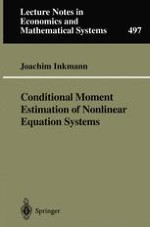2001 | OriginalPaper | Chapter
Overidentifying Restrictions
Author : Dr. Joachim Inkmann
Published in: Conditional Moment Estimation of Nonlinear Equation Systems
Publisher: Springer Berlin Heidelberg
Included in: Professional Book Archive
Activate our intelligent search to find suitable subject content or patents.
Select sections of text to find matching patents with Artificial Intelligence. powered by
Select sections of text to find additional relevant content using AI-assisted search. powered by
In this section it is shown that the asymptotic efficiency of GMM estimators may increase with an increasing number of overidentifying restrictions. According to the two components of the unconditional moment functions defined in (2.1.4), there are generally two approaches to gain overidentifying restrictions which may be combined. The first approach takes the vector of conditional moment functions as a given and enlarges the set of instruments with additional instruments which do not depend on additional unknown parameters. Using an argument of Davidson and MacKinnon (1993, p. 603), it can be readily seen that the resulting GMM estimators are asymptotically at least as efficient as the ones obtained using the original set of instruments. Taking into account the findings of Section 5.2, this result is shown here for the optimal choice of the weight matrix. Let ψ(Z, θ)= A(X)ρ(Z, θ) denote the unconditional moment functions of the model as introduced in Section 2.1 using the enlarged set of instruments. As seen above the asymptotic variance-covariance matrix of $$\hat \theta $$ equals (G0′V0-1G0)-1 .For some r′ ≤ r consider a r×r′ transformation matrix S which selects some instruments, or linear combinations of some instruments, contained in A(X) such that S′A(X) is a new matrix of instruments with dimension r′×s. The asymptotic variance-covariance matrix of $$\hat \theta $$ associated with this transformed model can be derived as (G0′S(S′V0S)-1S′G0)-1. In the following it is proven that this matrix exceeds the original variance-covariance matrix, in the sense that their difference (G0′S(S′V0S)-1S′G0)-1 − (G0′V0-1G0)-1 is positive semidefinite.
